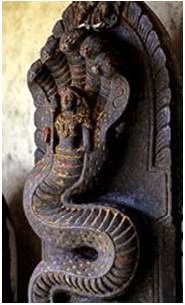 Idol of Naga Subrahmanya
Idol of Naga Subrahmanya
Palakkad is a place in East Kerala, which receives copious rains because of its occurrence on the windward side of the Western Ghats. Nemmara is a taluk of Palakkad District and is at about 30 km south of the Palakkad railway station. Nemmara includes a few villages. One of them is Kannimangalam, where three temples exist: one is a Shiva temple on the north-eastern corner of the village, the second is a Devi temple at the south-eastern end, and the third is a temple for Nagasubrahmanya on the western end. The idol of Nagasubrahmanya faces the east and the rays of rising Sun illuminate the deity early in the mornings.
Subrahmanya is worshipped in Tamil Nadu more intensely than in Kerala. His six padai-veedu-s (or warrior abodes) are in Tiruttani, Swamimalai, Tiruchendur, Thiruparangkundram, Pazhani, and Pazhamuthircholai. These six temples are said to correspond to the Shadchakras or the six tantric points in human body, viz., muladhara, swadishthana, manipura, anahata, vishuddhi, and ajna. The temple which corresponds to Sahasrara is the Subrahmanya temple in Kathirgamam, Sri Lanka.
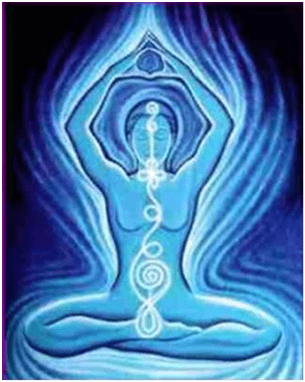 Shadchakras of Body
Shadchakras of Body
Naga refers to a snake and Subrahmanya to Muruga. How did Muruga come to be worshipped in the form of a snake? Once Brahma visited Mount Kailasa, the abode of Shiva, where Brahma was questioned by Murugahow he carried out the art of Creation. Brahma replied that he was creating as indicated in the Vedas. Brahma recites the Vedas, starting with pranava (Om).Muruga interrupts Brahma,seeking an explanation of the pranava. Unable to explain its meaning, Brahma was imprisoned. Muruga takes on creation and Brahma’s absence goes unnoticed. The only folly that occurred was that in Brahma’s creation no two beings were identical, whereas during Muruga’s creation no variation occurred. Attempts to persuade Mahavishnu to meditate failed and Shiva interferes in securing Brahma’s release from imprisonment. On Shiva’s intervention, Muruga refused to relent on the reason that a person ignorant of the meaning of pranava is unsuitable for doing a critical task such as creation. Shiva demands that Muruga explain the meaning of the pranava.
In Brahmopadesam ceremony (Upanayanam),the biological father of the disciple officiates as Guru for the disciple. Here Shiva – father of Muruga – should be the Guru. But by accepting Muruga as Guru,Shiva displaysan egoless state. Muruga explains the meaning of Om to Shiva and the place where this incident took place is Swamimalai, near Kumbakonam in Tamilnadu. As mythology goes, later, Muruga repented for His action of imprisoning Brahma and decided to subdue Himself with the thought: “Since I thought I am higher than the highest, let me become lower than the lowestâ€. With this thinking, he transformed himself into a snake, which by crawling shows that nothing can be lower than it. This story explains why Muruga is worshipped as a snake.When
Goddess Parvathi came to know of this, she approached her consort, Lord Shiva to restore Muruga to his original form. Lord Shiva advised Parvathi to observe Shashti Vrtha, which Parvathi, in all sincerity, observed for 108 Shashtis. On the 108thShashti, Lord Muruga appeared in his snake form. Lord Vishnu and all the Devas were also there, and on receiving Vishnu’s Holy touch, Muruga regained his original form, that of a small boy (Muthukumara), much to the joy of all those present on that occasion.
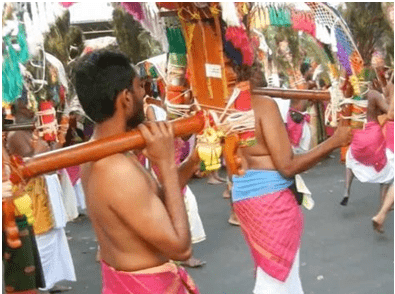 Devotee with Kavadi
Devotee with Kavadi
The main idol and a kavadi are worshipped. The kavadi was originally in the house of a devotee in Kannimangalam village,who used to conduct abhishekam with milk. Being poor and unable to afford the cost of this practice, he decided to leave the kavadi in Palani. It so happened that a person travelling towards Kannimangalam took the kavadi. On reaching Kannimangalam, he was tired and rested in the verandah of a house, which, incidentally, belonged to the same devotee, who was carrying the kavadi to Palani. Being surprised to regain the kavadi, the Kannimangalam devotee resumed his usual practice of worship. His house caught fire, and everyone thought that the kavadi was burnt. The kavadi was safe at the top of a tree in the backyard of his house. The devotee placed the kavadi under the banyan tree, which is now a part of Nagasubrahmanya temple. The kavadi at the temple precincts is worshipped on Thaipoosam day in January—February each year.
The main festivals of the temple are Kumara Shasti (November–December), Thai Poosam(January—February) and Pratishtaday (April–May, celebrated on Hasta star, Chitra month).
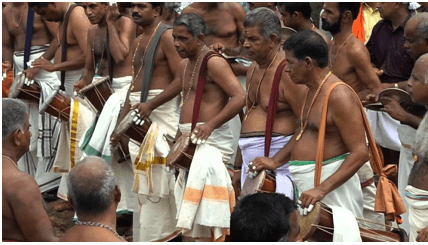 Kerala Drummers Performing in a Festival
Kerala Drummers Performing in a Festival
Almost all the best drummers in Kerala assemble for Kumara Shasti and the popular view is that the quality of the music for that festive occasion is as good as that of Thrissur Pooram. Some of the drummers say that the vibration in the temple portico is such that they forget themselves and what comes out is divine music –exactly the reason why they are not able to reproduce the same music, while performing at other places. A drummer, who had earlier agreed to come to Kannimangalam recently withdrew, since he had later signed for attending a music festival overseas. The Kannimangalam programme organizers were saddened that they were losing on a stalwart for an important occasion. It so happened that the overseas engagement got cancelled suddenly and the musician turned up as promised. Such events occur commonly in the context of Kannimangalam temple festivities.A devotee who had some health setbacks donated jaggery and in a short period he was completely cured. People of the village and devotees of the temple are usually blessed with long life and high levels of education by the grace of Nagasubrahmanya.
The following is an incident that happened in 2005.A devotee, a native of Kannimangalam, came to Chennai from Bangalore to finalise his daughter’s marriage. His daughter had white patches on her limbs, about which she was naturally, unhappy of. Another Kannimangalam native suggested to him to seek the blessings of Nagasubrahmanya; asked him to donate a silver vel and perform abhishekam to Nagasubrahmanya with milk during the annual festival. The father of the girl to be married followed the suggestion, participated in the annual festival of Kannimangalam (Shasti Vilakku),submitting a silver vel (spear) and completed the other votives. In two months,the white patches on the girl disappeared. That summer she was married and is now settled happily and blessed with a baby.
A lady, who is also a native of Kannimangalam, had just returned from the Middle East with her children to stay with her parents in Chennai. On reaching their house in Chennai, the lady removed the ornaments from her children, so that they play freely without the fear of losing the ornaments. While doing so, two gold bangles were misplaced. The family panicked, since losing gold ornaments is inauspicious. Intense
search did not provide any result. A family friend suggested them to light a ghee lamp in front of Nagasubrahmanya.The stressed family did that in sincerity. Within 48 hours, they spotted the missing bangles. Lord Nagasubrahmanya’s words, “Why fear when I am here?†came true.
This incident occurred in July 2012, and the family which experienced this miracle is related to me and therefore I am personally aware of this incident.
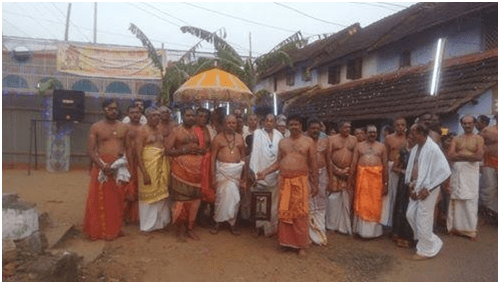 Temple Priests commemorating the Festival in Nemmara
Temple Priests commemorating the Festival in Nemmara
Recently a devotee had kept aside a sum of money to be donated to Nagasubrahmanya temple. She forgot about this, only to be reminded by a snake which appeared in their house.Promptly the money was secured to the temple.
Four peacocks settled near Kannimangalamtemple on 30 December 2011. Peacocks have never been found in Kannimangalam so far and of course, this was unusual. As the chief priest was about to commence usual puja, a snake emerged from the sanctum sanctorum on January 5, 2012. What appears significant in these two events is that 30 December 2011 was Sukla Shasti and 5 January 2012 was Krittika, both days auspicious for Subrahmanya. Since the occurrence of these events, Sukla Shasti is being celebrated every month.
The Kumbabhishekam of this temple took place on 20th April 2016 in a grand manner.Those who were fortunate to participate in this auspicious function were of the unanimous view that it was beyond all expectations. Festivals in this temple happen more on account of the glory and power of Lord Nagasubrahmanya than due to the efforts of an individual.
Subrahmanya – Devasenapati — is a soldier. Recall Krishna’s statement in Gita: “I am Skanda, among generalsâ€(Chap X; 24). Therefore Mars is the governing planet for Subrahmanya as Mars denotes bravery, weapons, victory in war, and combat skills.
Snakes are denoted by Rahu and to some extent by Ketu too. People who wish to propitiate Mars or the nodes achieve fulfillment by worshipping Nagasubrahmanya.
According to Nadi–Astrology, a person born near a temple of Muruga could have either Mesha or Vrischika as lagna, being Martian signs. Factually speaking, a number of people born in the village have these rising signs, which indicates the influence of Muruga, as a deity who bears affinity to Mars. Since Nagasubrahmanya is present here as a principal deity, all troubles attributable to nine planets would abate by His grace. Those who have Naga dosha, Manglik or Kala Sarpa dosha would also benefit immensely by praying to Nagasubrahmanya.
NADI REVELATIONS
Through the Nadi leaves Brahma Rishi Vishwamitra has been giving timely revelations about various events as well as information related to sprirituality.These leaves are technically known as “Jeeva Nadi†leaves where words appear and disappear and can be read only by a Nadi reader.Out of His Infinite Grace Brahma Rishi Vishwamitra has chosen to give valuable information related to the Nagasubrahmanya temple in Kannimangalam village,Nemmara,Palakkad district.
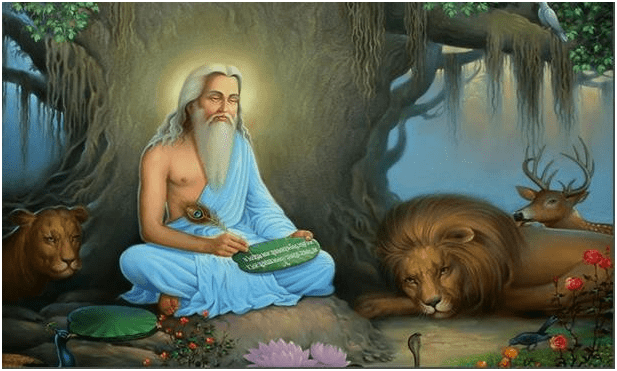 Sage Vishwamitra writing Nadi
Sage Vishwamitra writing Nadi
In Sri Nagasubrahmanya Temple the vehicle is a peacock. Usually a peacock holding a snake in its mouth is portrayed as if to indicate that a peacock is an enemy of the snake. On the other hand, the peacock and the snake are not enemies. The peacock represents the Sahasrara Chakra or the thousand petalled chakra at the crown of the head. The snake represents the Kundalini shakthi at the base of the spine. Under the magnetic power of the peacock (Sahasrara), the snake. (Kundalini) crawls upwards towards to the crown chakra resulting in the grand finale of self-realization.
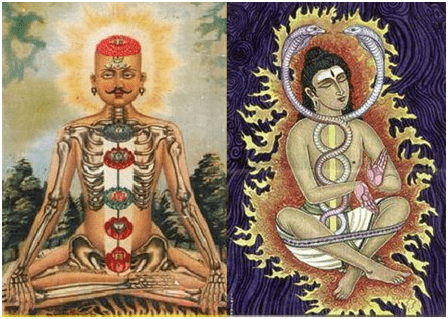 Kundalini evoking Self-Realization
Kundalini evoking Self-Realization
The story of Brahma being imprisoned and Muruga taking over creation is a legend pertaining to Satya Yuga. So, the concept of Nagasubrahmanya is as old as Satya Yuga.Originally the idol of Lord Nagasubrahmanya was in the backyard of a house but got shifted to the present location.
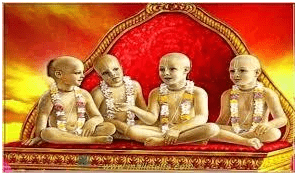 Sanatkumars
Sanatkumars
Rajoguna is the basis for creation. Under the influence of Rajoguna, Brahma creates Sanatkumaras.They are considered Manasaputras (or mind born sons) of Brahma, and are known as, Sanaka, Sanatana, Sanatkumara and Sanandana. Sanatkumara is the author of Sanatkumara Samhitha. It is believed that Lord Shiva was desirous of having Sanatkumaras as his sons. When it was decided to confer a boon, Sanatkumaras declined.They in turn asked Lord Shiva if he desired a boon; the latter jumped at the offer and requested Sanatkumara to be born to him as a son.
The latter readily agreed and was born out of Shiva’s third eye as Subrahmanya. Sanatkumara appears as a Rishi in Chandogya Upanishad. Sanatkumara is supposed to reside in the Sahasrara Kamala or the crown chakra.
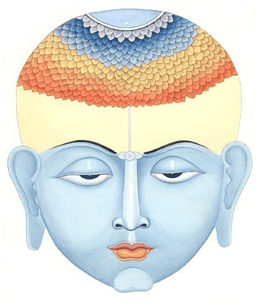 Sahasra Kamala or the Crown Chakra
Sahasra Kamala or the Crown Chakra
It is believed that Sanatkumara was born to Lord Krishna as his son, Pradyumna. When Brahma proceeded to create, he meditated on the supreme power which appeared before him, as the Sanakadi Rishis. Usually Kama (Lust), Moha (Infatuation) and Maya (Illusion) are the prerequisites for creation. When Lord Muruga who took over creation all creation was based on Jnana (Wisdom). At a fundamental level, Maya is opposed to Jnana and creation having Jnana as its basis is bound to be defective. Therefore, Lord Muruga’s creations were flawed as he created the 33 crore Devas, all of whom resembled each other whereas in Brahma’s creation, no two beings are similar.
Consequently, one who worships Lord Subrahmanya at the village of Kanimangalam in Nemmara (Palakkad district, Kerala) would not have to suffer for his mistakes. For
instance, one who has done something wrong is brought to court by an adversary. If this person were to worship Lord Muruga here, then the adversary would commit some mistake and lose his case. One having in his chart, the following conjunctions would benefit immensely by praying here.
1) Mars- Rahu Conjunction
2) Mars- Ketu Conjunction
3) Mars- Saturn Conjunction
Those with Naga Dosha in their charts would be relieved of their Doshas by praying here. In this temple Lord Nagasubrahmanya represents “Shakthi†unlike in other temples, where he represents “Shivaâ€. In a single place, he encompasses
the four forms of Durga, Kali, Muruga and Shiva. It is believed that if pooja is done here with Nagasubrahmanya Yantra and Nagasubrahmanya Mantra, immense benefits would accrue. The Nadi texts recommend a few modifications to the worship in this temple such as installation of a Yantra and chanting of appropriate Mantras to enhance the power and glory of his temple. This place is an ideal destination for those who wish to seek redemption from the sins of committing “Brahmahatya Dosha†(Killing of a learned person).